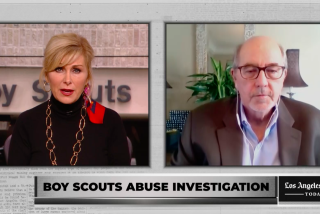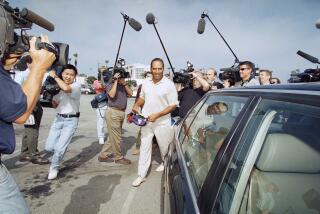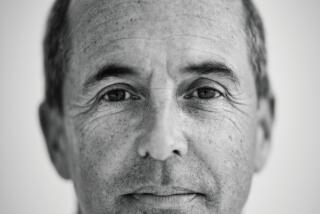A Times writer’s take on ‘True Detective’s’ Vinci: That was Vernon in a nutshell
My editor called early one June morning in 2012. Eric T. Fresch, the former top administrator for the city of Vernon, had been found dead at the bottom of a cliff in the Bay Area.
At the time, state auditors had been attempting to subpoena Fresch for an investigation. That day an audit had been released criticizing the city’s contracting and investment decisions while he was running Vernon. It’s likely that one of the last voicemails on Fresch’s cellphone was from a Los Angeles Times reporter.
The Marin County coroner would find three weeks later that Fresch, who had made $1.6 million one year as Vernon city administrator, — had died in a bizarre accident, apparently slipping on wet rocks and drowning in shallow water off Angel Island.
But it was hard not to wonder whether he had committed suicide — or been murdered. Cinematically, the timing was disturbingly perfect. And that was Vernon: An odd town that played the secrecy game with such aplomb that almost everything seemed cloak-and-dagger.
Vernon played the game so well it seemed only a matter of time before Hollywood would come knocking when it needed a muse for a bizarro, gritty kind of town where really bad things happened in vacuum-sealed secrecy.
Enter the second season of HBO’s “True Detective,” in which the murder of the city manager of the fictional town of Vinci is a major story thread. Even if Nic Pizzolatto, the creator of the series, didn’t already say so, it would be hard not to see that Vernon was the inspiration for Vinci. The water tank that looms over the industrial faux town with the word Vinci is perhaps Vernon’s most distinctive landmark, along with the mural-tattooed Farmer John plant.
The real-life Vernon City Hall is used in several shots, and you can see a few of the quaint wood-frame cottages that are among just a couple of handful of homes in a city that like Vinci numbers only about 100 residents.
Vernon’s city seal features two workers, a globe and a few factories belching smoke in the background. The city’s motto is “Exclusively industrial.” Vinci’s seal, with the motto “Towards tomorrow” is all belching smokestacks, like factories in Mordor in the “Lord of the Rings” trilogy. There are no humans.
Then there are the dead city managers. With Vinci’s, there is no doubt that someone killed him with extreme prejudice. Basically, Vinci out-Vernons Vernon by several factors.
But perhaps the most meaningful similarity between Vinci and Vernon is their devotion to the practice of a kind of municipal omertà. In Vinci, as it was in Vernon, silence is a god.
The city of Vernon has appeared to turn some corner from its shadier days, opening up its officials to questions, expanding the size of the city’s population and generally being far more transparent. Vernon even allowed “True Detective” to film in the city. Vernon 2015 is not Vernon 1990, 2006 or 2010.
But for generations, secrecy was absolutely central to how Vernon operated. Basic information was kept under lock and key. And so you wondered about everything — including a death that the authorities said was strictly accidental.
“That low background rumble is the sound of paper shredders on the third floor,” one person in the fake City Hall tells Colin Farrell’s Vinci Det. Ray Velcoro in the HBO drama.
In that regard, at least Vernon may have had Vinci beat. According to L.A. County district attorney records, Fresch ordered a city official to make sure magnetic tapes and other city financial records were taken to a fire station, where firefighters were to set them ablaze.
I first covered Vernon in 2006, then four years later, this time with my colleague Kim Christensen and former colleague Sam Allen. By that time the city had become more sophisticated. Where before Vernon officials maintained a monk-like silence that told you to go pound sand, now at least they had someone who politely answered your calls even if that person ended up telling you basically the same thing.
Still, the city was beginning to share, if reluctantly, more information.
In “True Detective,” Vince Vaughn’s developer-cum-criminal character Frank Semyon practically hisses at a subordinate: “This place is built on a codependency of interests. It worries me you’re talking so stupid.”
That’s pretty much what Vernon felt like. The silence always seemed designed to prevent some awful domino effect. The five council members were carefully shielded from reporters, especially those who might actually ask pointed questions. But the council members were never whom you really wanted to talk to anyway.
Even after Vernon hired a relatively responsive spokesperson, the gears of the city worked to keep you from getting answers and certainly from cornering the town’s real movers and shakers. Especially Fresch, who by most accounts seemed a genial guy with a math-whiz brain and a profound aversion to publicity.
The overall effect of Vernon’s weirdness, like Vinci’s, meant that it didn’t feel like a real city. At one point an investigator on the TV series asks Velcoro, “What the … is Vinci?”
Velcoro responds dryly: “A city. Supposedly.”
That “supposedly” a city made Vernon vulnerable to a state legislature effort in 2011 to eradicate the town through the process of disincorporation. Vernon’s salvation came at the cost of a series of reforms, which the city seems, to a certain degree at least, to have taken seriously.
No matter how strange Vernon was in its heyday — and this was a city that set private investigators with guns after a group of people who sneaked into town to run for office — no hired goons ever beat up a Los Angeles Times reporter.
In one scene in “True Detective,” Velcoro waits in his car as fictional L.A. Times reporter Dan Howser, who is penning an investigative series on Vinci, arrives at his ratty apartment clutching his laptop and a stack of documents to his chest. Putting on a ski mask, Velcoro runs into poor Howser’s apartment and beats him.
The next day he hands Semyon the files and laptop and cracks, “He’s not going to be writing that story no more.”
First of all, this isn’t one of those countries where newspaper reporters get roughed up to kill a story, let alone murdered. And judging by Howser’s story, which you can read if you screen-grab the newspaper in one scene and magnify, the other reporters would do a lot better job than Dan.
Because if you can’t get an eight-part Los Angeles Times investigation on the front page instead of having it buried inside, you probably deserve to get beat up.
More to Read
The complete guide to home viewing
Get Screen Gab for everything about the TV shows and streaming movies everyone’s talking about.
You may occasionally receive promotional content from the Los Angeles Times.







